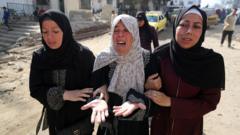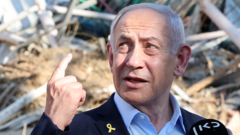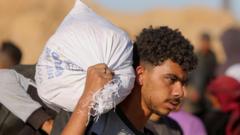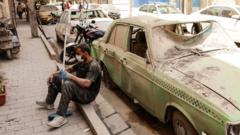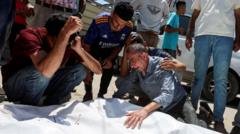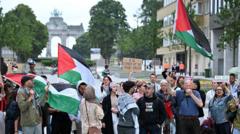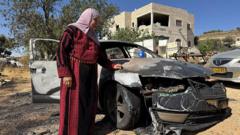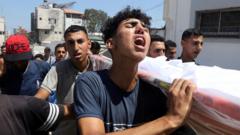Following the introduction of a new aid system in Gaza, reports show a surge in violence and chaos, with over 500 casualties among aid seekers attributed mainly to Israeli fire, raising grave concerns about the safety and efficacy of the distribution effort.
Chaos and Gunfire Mark One Month of New Aid Distribution System in Gaza

Chaos and Gunfire Mark One Month of New Aid Distribution System in Gaza
A troubling analysis reveals the risks faced by civilians accessing aid in Gaza, as gunfire and fatalities disrupt the newly implemented aid distribution system.
In the month since a new US- and Israeli-backed aid distribution system was launched in Gaza, reports indicate a significant increase in violence and disorder, undermining the very purpose of the program. An analysis by BBC Verify of numerous videos has documented alarming incidents of gunfire occurring close to civilians attempting to collect aid. Eyewitness accounts and reports from the Hamas-run health ministry reveal that over 500 Palestinians have lost their lives while pursuing aid, with an additional 4,000 sustaining injuries—most of these incidents being attributed to Israeli military fire.
Despite the lack of definitive evidence identifying those responsible for the fatalities, it is clear that confusion and ongoing danger plague the aid distribution process. The Israel Defense Forces (IDF) maintain that they have fired “warning shots” at individuals perceived as threats. They claim that Hamas actively obstructs aid distribution and puts civilians in harm's way.
The aid distribution system was initiated following Israel's decision to ease an 11-week blockade, which had aimed to pressure Hamas into releasing hostages. Four aid distribution sites were established in IDF-controlled areas, operated by contractors working for the Gaza Humanitarian Foundation (GHF). Despite the intention to facilitate access to food and resources, the UN and other organizations have condemned the plan as likely to "militarise" aid, pushing recipients into dangerous zones.
Early reports following the system's implementation highlighted the tragic outcomes associated with dangerous access routes, culminating in public outcry and international backlash after a series of deaths occurred as individuals approached aid locations. The IDF has stated that they are making efforts to improve operational responses and reduce friction with civilians, a claim that contrasts sharply with the ongoing reports of civilian casualties.
Medical personnel from the Red Cross reported activating mass casualty procedures numerous times since the start of aid distribution, indicating the scale of emergency healthcare needs arising from gunfire-related injuries. The UN has categorized the killings of civilians seeking aid as potentially constituting war crimes under international law.
Videos circulating on social media depict chaotic scenes where civilians scramble for supplies amid bursts of gunfire—footage verified by BBC shows both panic and numerous wounded individuals. Audio analyses of the footage have identified firearm sounds consistent with those used by both IDF and Hamas forces, leaving the source of violence unclear.
There are also reports of casualties occurring outside GHF-related sites, where significant loss of life was observed as people awaited aid. The IDF acknowledged this loss, expressing regret for those inadvertently harmed while emphasizing its operational necessity.
During this turbulent month, the GHF claims it successfully distributed 46 million meals to nearly two million residents, though they acknowledge that continued improvement in access systems and safety communications is required. Meanwhile, the overarching solution remains tied to the provision of sufficient aid to ease desperation among the population.
The situation persists as a focal point of scrutiny and debate, with calls for comprehensive assessments of the humanitarian approach amidst ongoing violence impacting the lives of civilians in Gaza.

